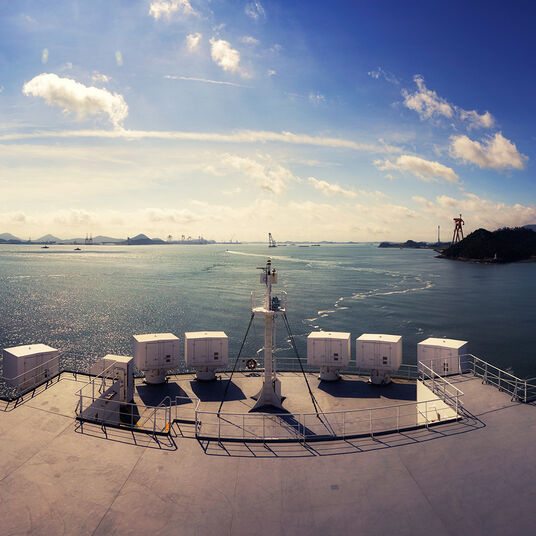What is green ship recycling?
When a vessel is ready to be retired, green ship recycling is the most sustainable, safest way to end its service. At Wallenius Wilhelmsen, we’ve been practicing responsible recycling for decades. With two vessels in our fleet now ready to be recycled, our green policies ensure they are scrapped in the most environmentally sound and transparent way possible.

Whether it’s a question of efficiency, age, operational health or overcapacity in our fleet, none of our vessels can ride the waves forever.
Over the years, we’ve responsibly recycled a number of vessels under the supervision of trusted green recycling partners such as Grieg Green. Currently, two of our vessels are in the process of being dismantled according to EU regulations at recycling yards in Turkey.
“All our end-of-life vessels are dismantled under strict conditions at craned berths and landing facilities to ensure that operations do not pose any unnecessary risks to the environment or the safety of workers,” explains Captain Filip Svensson, marine operations, Wallenius Wilhelmsen. “Contracted on-site representatives closely monitor the entire process and have the authority to stop work immediately if anything is not in accordance with our safety, environmental or welfare standards.”
This policy applies to not only Wallenius Wilhelmsen-owned vessels, but also vessels that are on long-term charter. “If we are using a vessel until the end of its life, our contractual terms state that the owner is not allowed to recycle it in a manner that we don’t approve of,” Svensson adds.
Dealing with hazardous materials responsibly
Wallenius Wilhelmsen’s green ship recycling practices are based on a strict and proper definition of the Hong Kong International Convention for the Safe and Environmentally Sound Recycling of Ships (HKC), which was adopted by the International Maritime Organization in 2009, and the EU Regulation on Ship Recycling (EU SRR). The HKC recognizes that recycling vessels responsibly is the most environmentally sound way to dispose of a ship at the end of its life, as over 90% of materials can typically be reused.
Much of a vessel’s weight is made of steel, which can be converted into bars and rods for use in the construction industry. Meanwhile hydrocarbons can be transformed into oil products, and everything from generators and batteries to lights can also be rehomed.
However, ships also contain many hazardous, toxic materials, which if not dealt with in an appropriate, traceable manner can cause damage to the ecosystem and human health.
“Every vessel we recycle has an inventory of hazardous materials and where these are located onboard – from radioactive materials used in fire detection systems to oil and refrigerants – so that all those involved in the recycling process know exactly where they are,” says Svensson. “It is essential for us that we have an overview of the process and know how these materials are being dealt with.”

Much of a vessel’s weight is made of steel, which can be converted into bars and rods for use in the construction industry. Meanwhile hydrocarbons can be transformed into oil products, and everything from generators and batteries to lights can also be rehomed.
A transparent approach to green ship recycling
Transparency, as always, is key to responsible recycling. At Wallenius Wilhelmsen, we take a ‘cradle to grave’ approach to the lifecycle of our vessels, meaning we are equally as stringent about how we recycle them as we are about how we build them.
As a founding member of the Ship Recycling Transparency Initiative (SRTI), an online platform for sharing information on shipping companies recycling policies and practices, all our recent recycling data will be published on the SRTI website. Customers, cargo owners, investors and financial stakeholders can then use this information to make informed decisions about the companies they do business with.
However, a lack of transparency regarding ship recycling continues to allow some operators to take approaches to recycling that are harmful to workers’ health and the environment.
According to the NGO Shipbreaking Platform, 630 ocean-going commercial ships and offshore units were sold to scrap yards in 2020. Of these vessels, 446 were scrapped on the shores of Bangladesh, India and Pakistan, amounting to almost 90% of the gross tonnage dismantled globally.
Unscrupulous shipping companies sell vessels to scrap dealers, known as cash buyers, that are often linked to these illicit beaching yards. Here, ships are grounded before being broken apart on tidal mudflats, where it is impossible to contain pollutants.
“Our agreement with our buyer regulates all aspects of responsible recycling,” says Svensson. “That means when we sell our ships to a recycling yard, our policy states that they are not allowed to sell it on to any other entity than the agreed and pre-approved recycling facility. Carefully vetting not only the yards in question but buyers too, ensures that all waste and recycled materials are treated properly and traceably.”
Customers, cargo owners, investors and financial stakeholders can use information from the SRTI to make informed decisions about the companies they do business with.
Regulatory standards to ensure responsible recycling
To try to curb this illicit trade and regulate the recycling process, there are several regulations in place. The European Ship Recycling Regulation, for example, states that EU-flagged vessels must be recycled in safe and environmentally sound facilities that are included in the European list of approved ship recycling facilities, while the European Waste Shipment Regulation prohibits vessels with any other flag to be taken from an EU port for recycling outside the OECD (Organization for Economic Co-operation and Development). In addition, the Basel Convention regulates exports of waste from an OECD country to a non-OECD country.
One of the challenges facing shipping companies, however, is that there isn’t enough capacity to provide recycling in line with these requirements. “Currently vessel recycling capacity in the EU is low, even though there is a need for a large volume,” admits Svensson, adding that Covid-19 has also had an impact by creating a backlog of ships waiting to be dismantled.
While there are a number of approved recycling yards outside of the EU, namely in Turkey and the US, looking to the future it is hoped that regulations will be put in place to approve more to prevent certain owners opting to have their ships recycled in non-regulated areas.
“As a socially responsible shipping company, we remain committed to green ship recycling and ensuring that all our ships are recycled in the most sustainable, safe and environmentally friendly way possible,” concludes Svensson.
The benefits of green ship recycling
- Ensure hazardous materials that pose a threat to both marine and human life are properly disposed of.
- Protect workers carrying out recycling by providing them with the correct safety equipment.
- Conserve marine ecosystems and the environment by removing all waste and debris.
- Recycle and reuse valuable materials, including steel, in other industries.
- Offer more green recycling jobs and a safe workplace.

